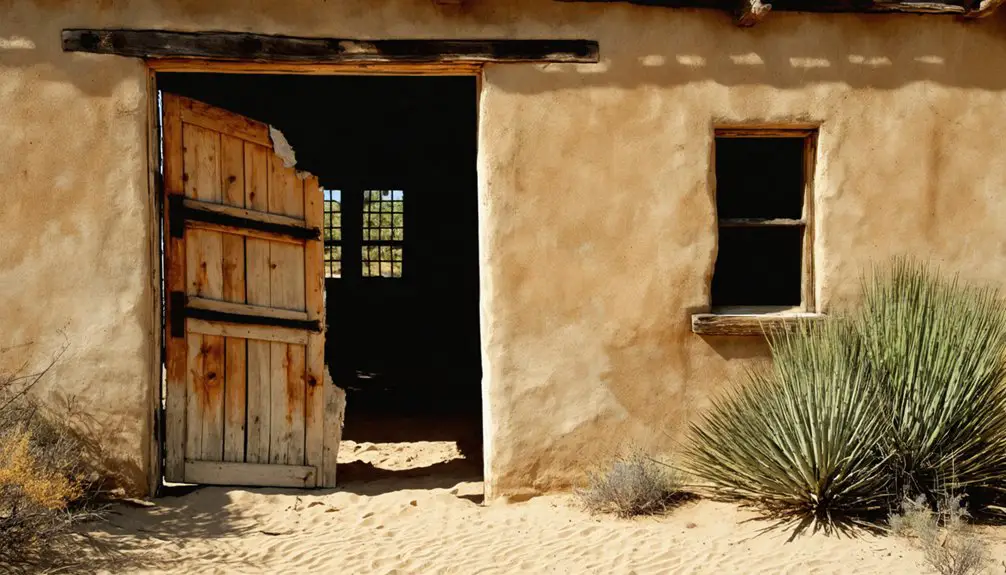You’ll find Lanark’s ghost town remains 30 miles northwest of El Paso, where it served as an essential Southern Pacific Railroad outpost in the early 1900s. The town supported steam locomotives with water tanks and fuel depots while operating a U.S. Post Office from 1905 to 1923. Today, its preserved water tank and adobe ruins stand as silent sentinels, while scattered mining equipment hints at the deeper story of this desert rail stop’s rise and decline.
Key Takeaways
- Lanark was a vital railroad outpost in Doña Ana County, New Mexico, serving as a crucial link between El Paso and Los Angeles.
- The town operated from the early 1900s until its gradual decline, marked by the closure of its post office in 1923.
- Essential infrastructure included water tanks and fuel depots that supported steam locomotives traversing the Southern Pacific Line through New Mexico.
- Located 30 miles northwest of El Paso, Lanark’s remote location contributed to its inability to reinvent itself after railroad operations declined.
- Historical remnants include an intact water tank, adobe ruins, and mining equipment, protected by preservation rules as archaeological artifacts.
The Rise of a Railroad Outpost
As steam locomotives pushed westward across the American Southwest in the early 1900s, Lanark emerged as an essential railroad outpost in Doña Ana County, New Mexico.
Located about 30 miles northwest of El Paso, this strategic stop along the Southern Pacific Railroad line served as a crucial link between El Paso and Los Angeles.
You’ll find Lanark’s story deeply intertwined with railroad expansion, as the site was specifically developed to support the demanding needs of steam locomotives. The name itself draws inspiration from the Scottish town of Lanark, which derives from ancient Brythonic meaning “clear space.”
The outpost featured critical infrastructure including water tanks and fuel depots, ensuring trains could continue their journey across the harsh desert terrain. The site’s location proved ideal for helper engines that were necessary to assist trains navigating challenging grades.
From 1905 to 1923, Lanark’s U.S. Post Office marked its significance as a community hub, while its position near Kilbourne Hole made it a recognizable landmark for rail crews.
Life Along the Southern Pacific Line
As you’d observe in Lanark during its heyday, Southern Pacific railroad workers spent their days maintaining tracks, servicing locomotives, and coordinating train movements through the station.
You’d find crews working around the clock at this crucial fueling stop, where steam engines took on water and coal before tackling the challenging desert terrain. The El Yaqui train passed through regularly on its route between Nogales and Mexico City.
Similar to other rail lines of the era, workers maintained a 3% grade limit to prevent train slippage on steep inclines. The maintenance yards buzzed with activity as workers repaired equipment, replaced worn rails, and kept the communication systems running to guarantee safe passage of both freight and passenger trains.
Railroad Worker Daily Life
Life along the Southern Pacific line in New Mexico revealed a diverse tapestry of railroad workers, with track gangs comprising white, Hispanic, Native American, and Asian laborers who faced grueling daily challenges.
You’d find these crews living in boxcar communities, working intense 20-day stretches without breaks, tackling everything from laying rails to tamping ties under the scorching desert sun.
Track gangs moved as coordinated units, managing the daily “rail pops” caused by New Mexico’s heat while maneuvering through treacherous arroyos with heavy survey equipment. These workers faced constant dangers from train traffic and machinery, making their jobs particularly hazardous.
Despite harsh labor conditions, workers forged strong bonds across cultural lines, creating tight-knit communities along the rails. Many Navajo track workers proudly maintained their cultural practices, performing traditional ceremonies and prayers before starting their shifts.
They’d relocate frequently between states, their families often following in mobile accommodations, adapting to life on the move while maintaining their distinctive cultural identities.
Fueling Stops and Maintenance
Through southern New Mexico’s arid landscape, the Southern Pacific Line maintained a sophisticated network of fueling stops and maintenance facilities that kept trains running smoothly along the Sunset Route. Today, modern facilities like Belen handle approximately 80 trains daily through their terminals.
You’ll find evidence of an extensive fuel supply infrastructure, including an 8-inch pipeline stretching 426 miles through Lordsburg, serving both military and commercial needs. By 1958, pipeline transport, rather than rail transport, handled 43% of U.S. petroleum distribution.
- Parallel pipelines up to 12 inches in diameter handled heavy rail traffic
- Modern “run-thru” stations allowed multiple trains to fuel simultaneously
- Booster pump stations maintained efficient fuel flow across vast distances
- Crew change buildings integrated with fueling stops for operational support
- 20,000-foot processing tracks enabled rapid inspections and maintenance
These strategic facilities revolutionized maintenance efficiency, transforming southern New Mexico into a crucial logistics hub while supporting continuous long-distance operations along the Sunset Route.
Essential Infrastructure and Operations
You’ll find a typical complement of railroad support facilities at Lanark, including a water tank and fuel depot that served steam locomotives on the Southern Pacific route between El Paso and Los Angeles.
Much like Lake Valley’s explosive growth period in the 1880s, these vital railroad facilities helped develop transportation infrastructure in southern New Mexico.
The water system’s infrastructure proved essential for steam engines traversing this arid stretch of southern New Mexico, while the fuel depot stored coal or oil to power the locomotives. The route extended approximately 109 miles long from near the Arizona border to El Paso, Texas.
These facilities represented the core operational requirements of an early 1900s railroad stop, enabling trains to refuel and replenish their water supplies during long-distance journeys.
Railroad Support Facilities
Railroad support facilities in Lanark showcased the extensive infrastructure needed to maintain narrow-gauge operations across New Mexico’s challenging terrain.
You’ll find these facilities were essential for railroad logistics and timber transportation across the region’s rugged landscape.
- Simple depot structures, sometimes starting as boxcars on pilings
- Freight yards designed for heavy logging operations
- Maintenance shops equipped for steam locomotive repairs
- Wooden trestles engineered for narrow-gauge specifications
- Storage areas for specialized logging flatcars
The facilities evolved from basic field setups to permanent commercial hubs, adapting to serve both passenger and freight operations.
As railroads expanded to reach timber locations and mineral deposits, these support centers became critical links in the transportation network, handling everything from equipment maintenance to cargo transfers.
Water System Operations
While railroad infrastructure shaped Lanark’s early development, the town’s water systems played an equally significant role in sustaining local operations.
Like many rural New Mexico communities, Lanark grappled with infrastructure challenges common to the region. You’ll find that water shortages and aging distribution networks posed significant hurdles, similar to those faced by nearby Truth or Consequences, where substantial water losses occurred through deteriorating pipes.
The town’s water operations required skilled operators to maintain both surface water and groundwater systems, though rural areas often struggled to retain certified personnel.
Traditional acequia systems supplemented modern infrastructure, helping to stabilize water availability during dry periods. However, without proper maintenance and staffing, these essential systems became increasingly difficult to sustain.
Daily Activities in a Desert Rail Town
As steam locomotives thundered through the New Mexico desert, Lanark’s daily rhythms centered on supporting the crucial Southern Pacific rail line between El Paso and Los Angeles.
You’d find workers checking train schedules, monitoring fuel levels, and maintaining the essential water supply that kept the steam engines running. Community interactions revolved around the railroad’s pulse, with the post office serving as a lifeline from 1905 to 1923.
- Railroad crews inspect tracks under the scorching desert sun
- Water tank operators measure levels to guarantee sufficient supply
- Maintenance teams service locomotives during scheduled stops
- Post office staff sort mail arriving by rail for local distribution
- Workers load coal and oil at the fuel depot, preparing for long desert runs
The Journey From Boom to Abandonment

Lanark’s story from vibrant rail stop to ghost town unfolded through technological change and shifting economic realities.
You’ll find its decline closely tied to railroad expansion westward, as steam locomotives gave way to diesel engines that didn’t need frequent water stops.
While you might’ve found a bustling scene in the early 1900s with trains regularly stopping for water and fuel, by 1923 the closure of the post office signaled the town’s economic decline.
Unlike other New Mexico ghost towns that fell to sudden disasters, Lanark’s fate came gradually.
The harsh desert environment, coupled with its remote location 30 miles from El Paso, left little chance for the town to reinvent itself once the railroad no longer needed it as an essential supply point.
Preserved Remnants and Structures
Standing sentinel in the New Mexico desert, the preserved remnants of Lanark tell a compelling story through their surviving structures and artifacts.
You’ll discover a site of profound archaeological significance, where strict historical preservation rules protect every fragment of the past. The town’s railway heritage remains visible through its water tank and fuel depot, while scattered ruins showcase early 20th-century mining town architecture.
- An intact water tank towers above, a symbol of Southern Pacific Railroad operations
- Adobe ruins of the Christian Endeavor building reveal traditional construction methods
- Mining helmets and equipment lie scattered near a massive mining pit
- Old glass bottles and metal drums dot the landscape, frozen in time
- Railway foundations and equipment stations trace the path of the El Paso to Los Angeles line
Legacy in New Mexico’s Transportation History
The small desert town of Lanark carved its place in New Mexico’s transportation heritage through its indispensable role in the Southern Pacific Railroad‘s operations.
You’ll find its impact woven into the economic development of the Southwest, as this strategic rail stop helped forge essential connections between El Paso and Los Angeles during the steam locomotive era.
Lanark’s water tank and fuel depot weren’t just infrastructure – they were lifelines that kept the wheels of commerce turning through New Mexico’s harsh desert expanse.
The town’s transportation evolution mirrors the broader transformation of the American Southwest, from its heyday supporting steam-powered trains to its eventual obsolescence.
Like countless frontier towns, Lanark rose and fell with the rhythms of the railroad era, its destiny bound to steam-era progress.
While Lanark’s physical presence has faded, its legacy lives on as a monument to the small but significant outposts that enabled New Mexico’s integration into the national rail network.
Frequently Asked Questions
Are There Any Reported Ghost Sightings or Paranormal Activity in Lanark?
You won’t find any documented ghostly encounters or spectral legends here – historical records and paranormal databases show no verified supernatural activity, despite the town’s abandoned railroad structures and remote desert location.
Can Visitors Legally Explore the Remaining Structures at the Ghost Town?
You’ll need explicit permission from landowners for legal exploration of the structures. Following visitor guidelines, don’t enter without authorization as the site likely sits on private property.
What Is the Closest Modern Town or Community to Lanark?
You won’t find Wi-Fi or modern amenities, but Hatch, New Mexico – famous for its chile festival and local attractions – is now the closest active community to this desert ghost town’s coordinates.
Were There Any Notable Crimes or Historical Incidents in Lanark?
You won’t find any notable crimes in Lanark’s history. Historical records don’t show significant incidents beyond routine railroad operations during its time as a Southern Pacific Railroad service point.
Does Anyone Maintain or Protect the Remaining Structures From Vandalism?
Like 60% of America’s ghost towns, you’ll find no formal preservation efforts or local organizations protecting these structures. There’s no documented caretaker, leaving the buildings vulnerable to both vandalism and natural decay.
References
- https://en.wikipedia.org/wiki/Lanark
- https://www.youtube.com/watch?v=O_1iT_a-Wzw
- https://a-curious-nature.com/2023/10/20/pseudo-ghost-towns-of-new-mexico-a-late-september-road-trip/
- https://www.newmexico.org/places-to-visit/ghost-towns/
- https://newmexicotravelguy.com/new-mexico-ghost-towns/
- https://www.youtube.com/watch?v=KLwZ4nk_jWk
- https://wheelsmuseum.org/?page_id=1654
- https://abqlibrary.org/railroads
- https://www.nmgastronome.com/?p=439
- https://en.wikipedia.org/wiki/Southern_Pacific_Railroad_of_Mexico



